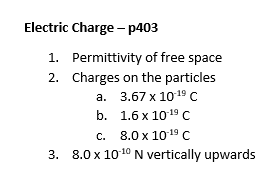An ion of mass m kg carrying a charge of –Q pC travels horizontally with a kinetic energy of Ek = 10 eV.
It enters a uniform vertical electric field of strength V kV m–1 , which is directed downwards and acts over a horizontal distance of 100 cm.
Which row in the table below correctly shows the time for the ion to pass through the field, and the magnitude of the force on the ion?
time / s force
A.
F nN
B.
F nN
C.
F µN
D.
F µN
Choose your answer A B C D
View Answer
Next Question
Point charges, each of magnitude Q are placed at three corners of a square as shown in the diagram.
What is the direction of the resultant electric field at the corner with no charge?
Choose your answer A B C D
View Answer
Previous Question Next Question
Which one of the following cannot be used as a unit for electric field strength?
Choose your answer A B C D
View Answer
Previous Question Next Question
What is the electric field pattern between a conducting sphere and an earthed metal plate?
Choose your answer A B C D
View Answer
Previous Question Next Question
A +1.0 nC and −1.5 nC point charge are placed 6 cm apart at points P and Q . A point R is equidistant to both charges .
If an additional charge of +4.0 nC is supplied to both charges, what is the magnitude of the electric field at R and the direction of this field?
Magnitude of electric field strength Direction of electric field
A. 0.3 k × 10−5 N C−1
Towards X
B. 0.3 k × 10−5 N C−1
Towards Y
C. 0.1 k × 10−11 N C−1
Towards X
D. 0.2 k × 10−13 N C−1
Towards Y
Choose your answer A B C D
View Answer
Previous Question Next Question
A student queries their answer after solving some physics problems. The teacher explains that the problem lies in the text book solutions, some of which are incorrect.
An extract from the mark scheme is shown below:
Without calculation, which answer does the teacher know to be an error?
Choose your answer A B C D
View Answer
Previous Question Next Question
Electric field strength is defined as 'the electric force per unit charge experienced by a small, positive point charge q '.
Why is the test charge described as 'small'?
Because electrons are small.
To obey Coulomb's law for point charges.
So that the electric field is not distorted.
So that the test charge does not exert a force on other charges in the region.
Choose your answer A B C D
View Answer
Previous Question Next Question
The electric potential at different points between two point charges is shown.
The electric field strength E varies along the line which connects P and Q.
Which graph correctly shows this variation, where x is the distance along the line PQ?
Choose your answer A B C D
View Answer
Previous Question
The diagram shows points X, Y and Z marked on a pattern of electric field lines. The spacing between X and Y and between Y and Z are the same.
The potential at X = 0 V and at Y is − 500 V.
What is a likely value for the potential at Z?
Choose your answer A B C D
View Answer







